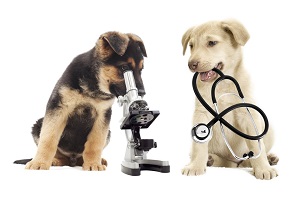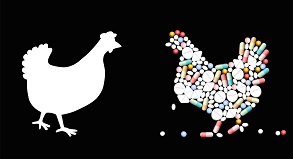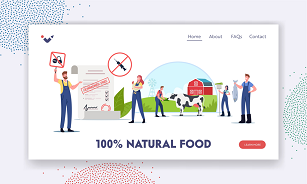Veterinary use of antibiotics has become a major source of concern and annoyance. And this doesn’t even concern the use as a medicine. For that is dwarfed by the application as an additive to fodder. This may be the most important cause of resistance. We shouldn’t have to ask patients in hospitals if they recently visited a farm, or have been in contact with pigs, should we?
Project ‘100 years of antibiotics’
Episode 41. Sore throat, runny nose and other unfortunate conditions
Episode 42. Disputable applications
Episode 43. Veterinary use
Episode 44. The decline of modern pharma in three acts. I: 1980-2000
Episode 45. The decline of modern pharma in three acts. II: the empty promises of biotech

Additive to fodder
Many countries, primarily in Europe, have taken measures against excessive use; but worldwide, there is room for much improvement. Some sources tell us that early this century, humans used less antibiotics than cattle, pigs, chickens and fish taken together. In the past, animals were fed cheap and simple medicines, but nowadays veterinary use is clearly in competition with humane use.
Major consumption of antibiotics in fodder starts around 1950; it coincides with the start of intensive livestock farming. Chickens are the first animals to get them administered in their fodder and drinking water. The argument used is that they live in close proximity; they could easily contaminate each other. Farmers should therefore administer antibiotics preventatively to them. But this argument is being mixed all the time with the profitable use of the substance: the animals grow better and faster on them. After chickens, treatment of pigs and calves starts. The final major group consists of fish (including prawns and other sea life); a large share of these animals on the market have been grown in fishing ponds, where they live closely together.

Large-scale use
Reports indicate that the veterinary use of antibiotics (far) outstrips that of humane use. Particularly at the start of the 21st century, use in animals is scarily high. According to a study in Proceedings of the National Academy of Sciences in 2015, yearly use in animals amounts to 63,000 tons; supposedly that is twice what doctors prescribe to their patients. A study in 2013, commissioned by the World Economic Forum mentions the amount of 131,000 tons in animals and 40,000 tons in humane use. However, these numbers are the result of extrapolations, rather than of proper market research. In the US, supposedly 80% of all antibiotics is for veterinary use. In the UK, the balance is slightly better: 2/3 humane use vs. 1/3 for animals. In both countries, five medicines add up to more than 80% of total consumption: penicillins, tetracyclines, macrolides, trimethoprim/sulfas and chinolones. Unfortunately, medicines reserved for humans as an agent for last resort are often used in animals.
Environmental pollution
This large-scale use comes with its consequences. Through these practices, farmers can cover up unhygienic conditions in their company or on their farm. Worse, antibiotics are being discharged to the environment in the form of manure, and they also end up in meat and animal products; through the food chain, they are consumed by humans. According to some studies, animals secrete up to 90% of the antibiotics administered to them. An environmental pollution unheard of. This even threatens the quality of our drinking water. In fish farms, we cannot prevent discharge to the environment. And that is precisely where as much is administered to animals as anywhere: 0.53 kg of antibiotics per ton of salmon in Chile. Fish farms in Vietnam, Thailand and China charge the environment with just a little less. Consequently, we find an increasing amount of bacteria resistant to antibiotics in sea food. Since 1990, this amount has grown by a factor eight.
Moreover, problems aren’t just caused by the food industry. Pharmaceutical companies discharge antibiotics into the environment through their waste water, and so do organizations like hospitals and nursing homes. And then we didn’t even discuss vegetables and fruit being sprayed with antibiotics. In 2016, the General Assembly of the United Nations formulates that the use of antibiotics in animal husbandry is the main cause of the accelerated pace of resistance.

Regulation?
The amount of antibiotics in fodder varies a lot. In order to enhance growth, fodder contains 2 to 50 gram per ton; in special circumstances like disease or stress, this might increase to 50 or even 200 grams per ton. Therefore, overdoses may not be exceptional. Regulation is difficult, for the sale of fodder is free. Already in the ‘80s, it becomes clear that there is a direct connection in resistance between animal and humane use, for a number of antibiotics. Other effects of animal antibiotics use on public health have never been proven. England is the first country to start regulation, around 1980. At present, we clearly know that resistance is mainly caused by use of antibiotics in our (animal) food chain. And yet, regulation is still far away.
In 2016, 193 countries signed a UN declaration on the control of resistance to antibiotics. The declaration went with the remark that animal use is the main cause of resistance: up to 90% of animal use will end up in the environment (mentioned before)! In 2017, US FDA starts regulation. Farmers cannot use antibiotics anymore for growth enhancement. And the acquisition of antibiotics comes under supervision of the vet. But it is still early times for conclusions on the effect of these measures. Notwithstanding actions like these, the G20 ministers of agriculture still have the issue prominently on their agenda.
And now, the tides turn in Europe. In 2006 already, the EU bans use of antibiotics for non-medical purposes. The Scandinavian countries lead the way in banning use in fodder, early this century. That by itself caused a major reduction in therapeutic applications! Other countries in NW Europe follow suit. The UK for instance, met the goal of 50 mg of antibiotics use per kg of meat produced in 2016, whereas it had been set for 2018 (still, this was 10 years after the EU ban). And even in the Netherlands, where problems are always solved using dialogue, non-therapeutic use is being reduced. In the rest of the world much needs to be done.
Alternatives
It is obvious that any measure improving animal wellbeing will be for the good. Fortunately, intensive animal farming has peaked now in many countries. Another important factor is that meat consumption is being reduced. For some time, farmers started to use vaccines instead of antibiotics-enriched fodder. But injection of all animals is expensive and time-consuming. Therefore, here too generic measures are being developed, like spraying the product on the animals or their products (i.e. eggs). The US now have approved more than 2,000 vaccines for animal use. But of course, if such measures are used generally and intensely, the same problems will pop up as described for antibiotics.
We might stimulate the animals with more healthy food. For instance food with probiotics (that contain useful intestinal bacteria); or with prebiotics (the proper food for the already present intestinal bacteria, stimulating them). And there are other common growth enhancers; citric acid or lactic acid, and vegetables like peppers, garlic, thyme and ginger. Brewers grains are often recommended. Nowadays, our knowledge grows of processes that determine the health of plants; and the functioning of insects and microorganisms. Those insights are instrumental for a better approach to animal fodder as well.
Veterinary use
Of course, vets prescribe antibiotics in order to cure animals fallen ill. But use of antibiotics as a growth enhancer is much larger. If horses are concerned, the goal is wellbeing and performance; if cows are concerned, milk production is decisive mostly. At the turn of the century, many farmers had penicillin at their disposal (legally or not) in a fridge, in order to treat infections of the udders and to dry off dairy cows. But if milk contained traces of penicillin, this would complicate or even prevent cheese production. And that often happened. Penicillin stands in the way of the proper function of the enzyme chymosine in the rennet that coagulates the milk. And then, we didn’t even discuss the use of antibiotics in pets. Much on the rise over the past decades. Likewise in zoos. This starts to look like humane use.
Sources:
Wikipedia: all names and products mentioned
N0-nonsense Guide to Antibiotics, Moira Dolan, SmartMedInfo, 2015; ISBN: 978-09968860-2-4
Antibiotica gebruiken in de veehouderij | RVO.nl | Rijksdienst (2021) (in Dutch)
Antibioticagebruik en veehouderij: ESBL en MRSA in dieren en de genomen controlemaatregelen | RIVM (2012) (in Dutch)
Dutch farmers just say no to antibiotics for livestock. The Abstinence Method | Modern Farmer (2014)
How do we reduce antibiotic resistance from livestock? – Our World in Data (2017)
Animal Health Guide 2021: Use of Antibiotics in Animal Feed – Wilco Farm Stores
Antibiotics in Animal Feeds, Antibiotics In Animal Feeds – The Effects on Human Health of Subtherapeutic Use of Antimicrobials in Animal Feeds – NCBI Bookshelf (nih.gov) (1980)
G20 countries advised to end antibiotic abuse on farms (worldanimalprotection.org.au) (2021)
IMPORTANCE OF GROWTH PROMOTERS IN POULTRY – Pashudhan praharee (2020)
